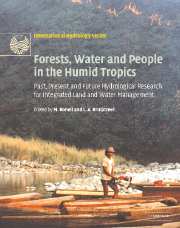 Forests, Water and People in the Humid Tropics
Forests, Water and People in the Humid Tropics from Part II - Hydrological processes in undisturbed forests
Published online by Cambridge University Press: 12 January 2010
INTRODUCTION
This chapter deals mainly with undisturbed tropical rainforests and its aims are threefold:
to summarise the current knowledge of selected topics in rainforest mineral nutrition;
to emphasise the links between hydrology, pedogenesis and rainforest mineral nutrition; and
to identify the most important gaps in knowledge and to suggest the most promising lines of research.
The rainforest nutrient cycle
Nutrients enter the ecosystem with rain, deposition of dust and aerosols, by fixation by microorganisms (in the case of N) above and below ground, and (except for N) by weathering of the substratum (Figure 16.1). The major above-ground pool of nutrients is formed in the tree boles and large branches. There is a flow of nutrients from these and the many other components of the above-ground pool of nutrients to the forest floor in small and large litterfall and in throughfall and stemflow of rainwater, enriched by nutrients from leaves and bark. The nutrients in dead organic matter are released gradually by decomposition, mediated by soil animals and microorganisms. Decomposition can involve immobilisation of nutrients as well as their release. In extreme cases the immobilisation may involve a conversion of the litter to stable organic matter which holds nutrients indefinitely. Such occurs in those forest types that have very wet or acid conditions (such as heath forests, peat swamp forests and upper montane cloud forests) which are described by Whitmore (1984).
To save this book to your Kindle, first ensure no-reply@cambridge.org is added to your Approved Personal Document E-mail List under your Personal Document Settings on the Manage Your Content and Devices page of your Amazon account. Then enter the ‘name’ part of your Kindle email address below. Find out more about saving to your Kindle.
Note you can select to save to either the @free.kindle.com or @kindle.com variations. ‘@free.kindle.com’ emails are free but can only be saved to your device when it is connected to wi-fi. ‘@kindle.com’ emails can be delivered even when you are not connected to wi-fi, but note that service fees apply.
Find out more about the Kindle Personal Document Service.
To save content items to your account, please confirm that you agree to abide by our usage policies. If this is the first time you use this feature, you will be asked to authorise Cambridge Core to connect with your account. Find out more about saving content to Dropbox.
To save content items to your account, please confirm that you agree to abide by our usage policies. If this is the first time you use this feature, you will be asked to authorise Cambridge Core to connect with your account. Find out more about saving content to Google Drive.